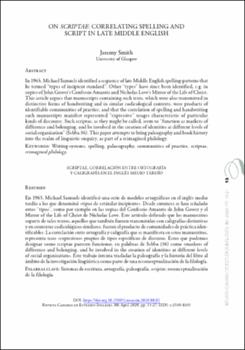On Scriptae: Correlating Spelling and Script in Late Middle English
Autor
Smith, JeremyFecha
2020Resumen
En 1963, Michael Samuels identificó una serie de modelos ortográficos en el inglés medio
tardío a los que denominó «tipos de estándar incipiente». Desde entonces se han señalado
otros “tipos”, como por ejemplo en las copias del Confessio Amantis de John Gower y el
Mirror of the Life of Christ de Nicholas Love. Este artículo defiende que los manuscritos
soporte de tales textos, aquellos que también fueron transmitidos con caligrafías distintivas
y en contextos codicológicos similares, fueron el producto de comunidades de práctica iden-
tificables. La correlación entre ortografía y caligrafía que se manifiesta en estos manuscritos,
representa usos «expresivos» propios de tipos específicos de discurso. Estos que podemos
designar como scriptae parecen funcionar, en palabras de Sebba (36) como «markers of
difference and belonging, and be involved in the creation of identities at different levels
of social organisation». Este trabajo intenta trasladar la paleografía y la historia del libro al
ámbito de la investigación lingüística como parte de una reconceptualización de la filología. In 1963, Michael Samuels identified a sequence of late Middle English spelling-patterns that
he termed “types of incipient standard”. Other “types” have since been identified, e.g. in
copies of John Gower’s Confessio Amantis and Nicholas Love’s Mirror of the Life of Christ.
This article argues that manuscripts containing such texts, which were also transmitted in
distinctive forms of handwriting and in similar codicological contexts, were products of
identifiable communities of practice, and that the correlation of spelling and handwriting
such manuscripts manifest represented “expressive” usages characteristic of particular
kinds of discourse. Such scriptae, as they might be called, seem to “function as markers of
difference and belonging, and be involved in the creation of identities at different levels of
social organisation” (Sebba 36). This paper attempts to bring paleography and book history
into the realm of linguistic enquiry, as part of a reimagined philology.





